| 1 | A. Face with a median projection that is approximately round in cross section; Neotropical, rare | Lasiophorus |
| – | B. Face with large, horizontal, dorsally concave plate-like projection; Neotropical, rare | 2 |
| – | C. Face without a projection; widespread, common | 3 |
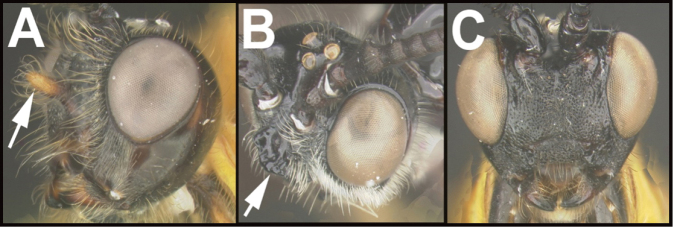
| ||
| 2(1) | A. First flagellomere with thorn-like projection | Cervellus |
| – | B. First flagellomere simple or occasionally slightly flared apically | Palabracon |

| ||
| 3(1) | A. Basal flagellomere (1) expanded ventrally | 4 |
| – | B. Basal flagellomere (1) simple, not expanded ventrally | 5 |

| ||
| 4 (3) | A. Scape shorter ventrally than dorsally (antenna directed anteriorly); flagellum uniformly dark, without white or cream-colored band at midlength; widespread | Coeloides |
| – | B. Scape longer ventrally than dorsally (antenna directed anteriorly); flagellum with white or cream-colored band at midlength; Neotropical | Megacoeloides |

| ||
| 5(3) | A. Scape with false sub-apical margin, well-separated from the real margin, and scape basally abruptly and concavely narrowing | 6 |
| – | B. Scape without false sub-apical margin, and scape basally gradually narrowing towards base. | 10 |

| ||
| 6(5) | A. Antennal sockets greatly protruding in profile; scape as wide as long; temple wider than eye; Neotropical, rare. | Calobracon |
| – | B. Antennal sockets slightly protruding in profile; scape longer than wide; temple shorter than eye. | 7 |
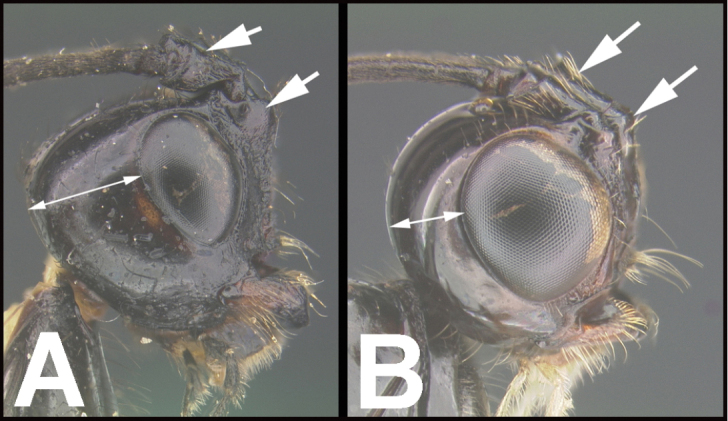
| ||
| 7(6) | A. Tergum 2 with triangular or (rarely) quadrate raised area narrowed posteriorly; widespread | 8 |
| – | B Tergum 2 smooth and flat or with a smooth posteriorly widening “pinched-up” area; Neotropical | 9 |
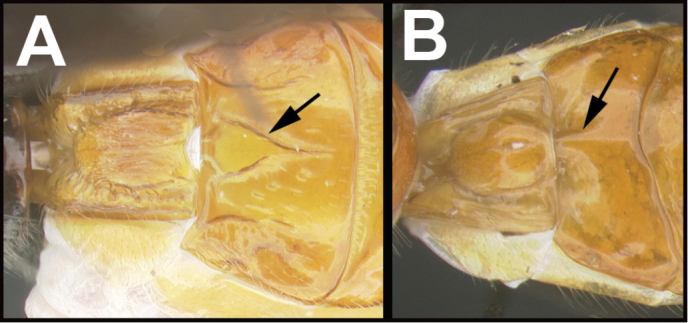
| ||
| 8(7) | A. Raised median area of tergum 1 with semi-circular emargination postero-laterally; Neotropical | Hemibracon |
| – | B. Raised median area of petiole without abrupt emargination postero-laterally; widespread. | Atanycolus |
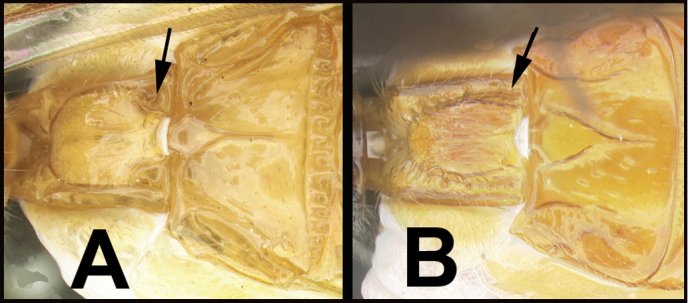
| ||
| 9(7) | A. Metasomal tergum 2 strongly ‘pinched-up’ antero-medially | Gracilibracon |
| – | B. Metasomal tergum 1 not or hardly ‘pinched-up’ antero-medially | Cyclaulax (in part) |
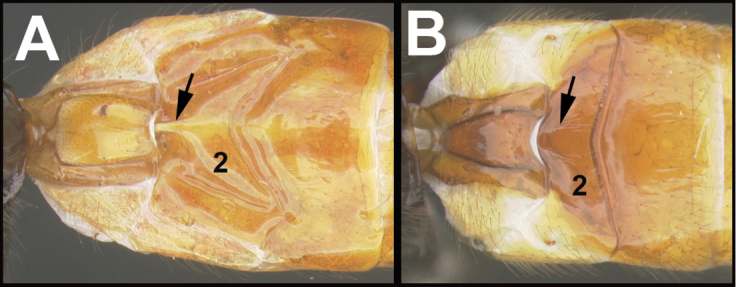
| ||
| 10(5) | A. Middle part of face clearly demarked from lateral parts by a pair of sub-medial, longitudinal carinae or rugose grooves running ventrally from the antennal sockets. AA. Metasomal tergum 2 without medial, basal, posteriorly-narrowing triangular area. | 11 |
| – | B. Middle part of face not clearly demarked from lateral parts by longitudinal grooves or carinae. BB. Metasomal tergum 2 often with medial, basal, posteriorly-narrowing triangular area | 16 |
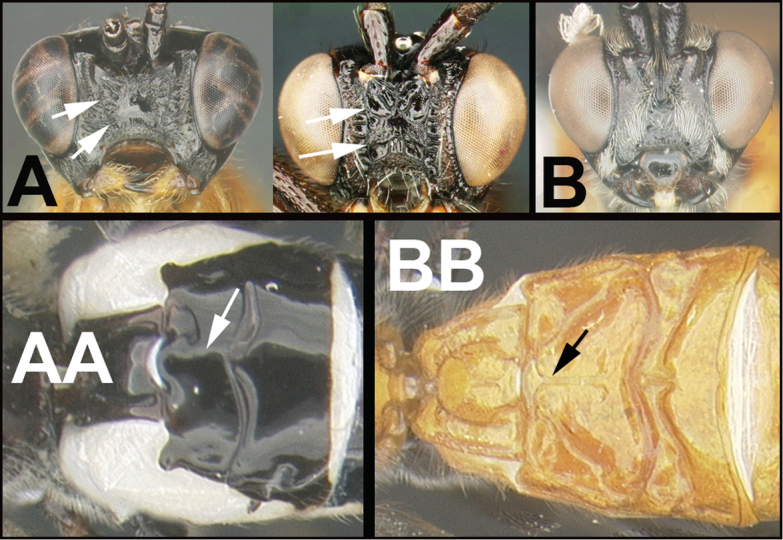
| ||
| 11(10) | A. Hypopygium truncated in lateral aspect | Compsobracon |
| – | B. Hypopygium acutely pointed in lateral aspect | 12 |
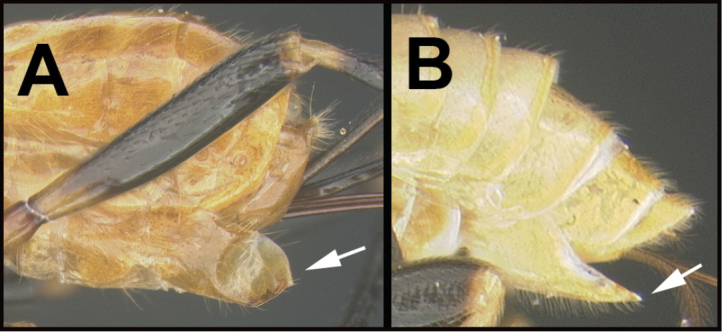
| ||
| 12(11) | A. Scape shorter ventrally (V) than dorsally (D) (antenna directed anteriorly) | 13 |
| – | B. Scape longer ventrally (V) than dorsally (D) (antenna directed anteriorly) | 14 |
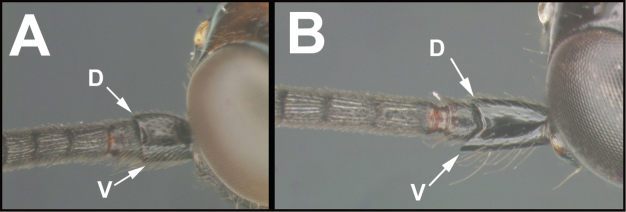
| ||
| 13(12) | A. Propodeum simple, entirely smooth; second metasomal tergite flat or weakly pinched anteromedially | Compsobraconoides |
| – | B. Propodeum with a distinct longitudinal carina posteromedially; second metasomal tergite more pinched-up medio-anteriorly | Gozmanycomp |
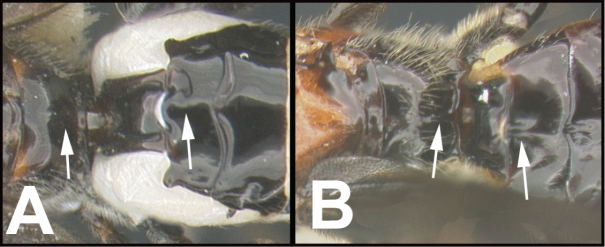
| ||
| 14(12) | A. Length of tergum 2 more than ½ as long as tergum 3 | 15 |
| – | B. Length of tergum 2 less than ½ length of tergum 3 | Cyclaulax (in part) |

| ||
| 15(14) | A. Face rugose with a lot of granulate sculpture, often with a raised granulate area medially. AA. Raised median area of petiole rather square in cross-section, lateral margin more or less carinate posteriorly | Cyclaulacidea |
| – | B. Face coarsely carinate-rugose medially with little or no granulate sculpture and without a raised granulate area medially. BB. Raised median area of petiole more rounded in cross-section | Sacirema |
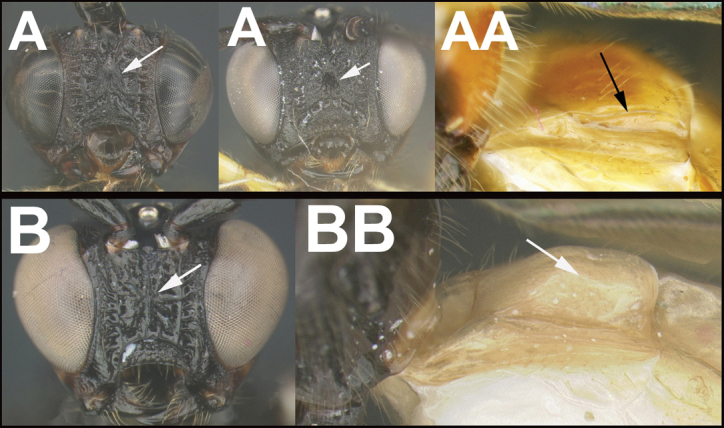
| ||
| 16(10) | A. Scape not, or only weakly, emarginate apicolaterally; scape shorter ventrally than dorsally (antenna directed anteriorly). | 17 |
| – | B. Scape apicolaterally emarginate; scape longer ventrally than dorsally (antenna directed anteriorly) | 24 |
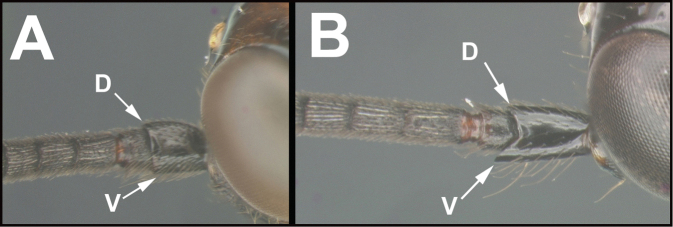
| ||
| 17(16) | A. Marginal cell of forewing short, vein 3RS reaching wing margin at most 0.7 × distance between apex of stigma and wing tip. AA. Clypeus with pair of long setae arranged in a cluster and often touching apically and/or AAA. Metasomal tergum 4 with characteristic pattern of fine striae that curve away from the midline; widespread. | Vipio |
| – | B. Marginal cell of forewing usually longer, vein 3RS reaching wing margin at least 0.8 × distance between apex of stigma and wing tip; if shorter, then BB. Clypeus without pair of long setae arranged in two clusters (clypeal guard setae evenly spaced and not touching apically. BBB. Metasomal tergum 4 without fine striae that curve away from the midline | 18 |
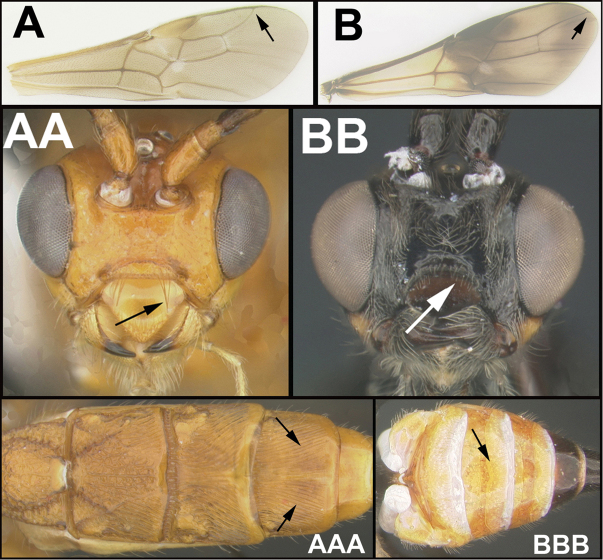
| ||
| 18(17) | A. Hind tibia strongly compressed laterally, very broad in lateral aspect, with conspicuously long setae. AA. Metasomal tergum 2 with a mid-longitudinal ridge; Neotropical | Myosomatoides |
| – | B. Hind tibia usually not strongly compressed laterally, usually without conspicuously long marginal setae. BB. If rather strongly compressed with long marginal setae (most Myosoma species) then metasomal tergum 2 lacking mid-longitudinal ridge | 19 |
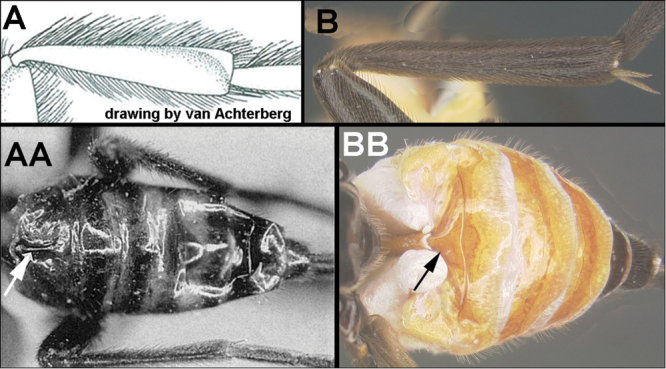
| ||
| 19(18) | A. Body very strongly depressed dorso-ventrally, mesosoma more than 2.8 × longer than maximally high; Nearctic, rare | Chartobracon |
| – | B. Body not or only moderately depressed dorso-ventrally, mesosoma less than 2.3 × longer than maximally high | 20 |

| ||
| 20(19) | A. Median tergite of petiole very long and narrow, more than 2.0 × longer than maximum width. AA. First tergum usually (in dead specimens) almost vertical and abutting propodeum, and therefore difficult to see | 21 |
| – | B. Petiole with median tergite not especially elongate, less than 2.0 × longer than maximum width, and first tergum more or less horizontal | 22 |

| ||
| 21(20) | A. Hind femur and tibia with short setae typical of Braconinae; introduced to Florida and a number of Neotropical countries | Amyosoma |
| – | B. Hind femur and hind tibia with long black setae; widespread | Myosoma |

| ||
| 22(20) | A. Propodeum and metanotum both with a complete lamelliform mid-longitudinal carina. AA. Sternaulus deep and crenulate; Nearctic, rare | Lapicida |
| – | B. Propodeum and metanotum both simple, or at most propodeum with a short mid-longitudinal carina posteriorly and/or with metanotum forming a short carina mid-anteriorly. BB. Sternaulus not depressed or if weakly depressed then not crenulate; widespread, common. | 23 |

| ||
| 23(22) | A. Fore wing 3RSa less than 1.5 × length of r (usually less than 1.2 ×); Antenna usually with fewer than 25 flagellomeres; widespread, common | Habrobracon |
| – | B. Fore wing 3RSa more than 1.6 × length of r (usually more than 1.8 ×); antenna often with more than 25 flagellomeres; widespread, common | Bracon |

| ||
| 24(16) | Propodeum coarsely sculptured. A. Forewing marginal cell short, vein 3RS reaching wing margin less than 0.8 × distance between apex of stigma and wing tip | Vipiomorpha |
| – | Propodeum smooth and shiny, at most with weak punctures at bases of setae. B. Forewing marginal cell long; vein 3RS reaching wing margin more than 0.8 × distance between apex of stigma and wing tip; forewing RS+M variable, but often distinctly curved or angled posteriorly shortly after arising from 1M | 25 |

| ||
| 25(24) | A. Ventral border of clypeus slightly concave in frontal aspect; flagellum with fewer than 50 flagellomeres | Alienoclypeus |
| – | B. Ventral border of clypeus slightly convex in frontal aspect; flagellum usually with more than 60 flagellomeres | 26 |
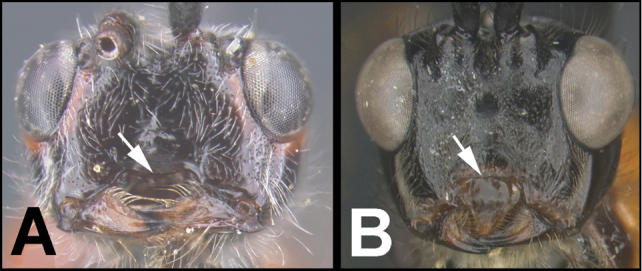
| ||
| 26(25) | A. Mandibles massive; Neotropical, rare | Gnathobracon |
| – | B. Mandibles of normal size; widespread, common | 27 |

| ||
| 27(26) | A. With three very long pseudo-ovipositors (more than 5 × longer than body) extending from anal region [true ovipositor (indicated by arrow) much shorter]; Neotropical, very rare | Pheloura |
| – | B. Without pseudo-ovipositors | 28 |
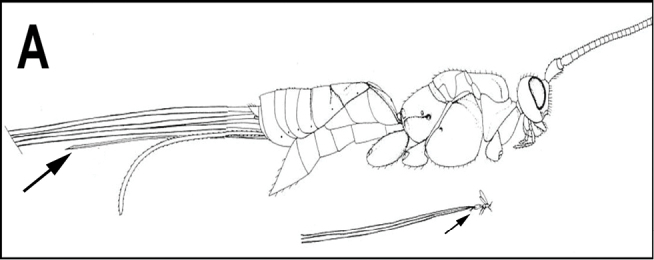
| ||
| 28(27) | A. Scape very long, more than 2.5 × longer than mid-width; Neotropical, rare | Megabracon |
| – | B. Scape much shorter, less than 2.0 × longer than mid-width | 29 |

| ||
| 29(28) | A. Metasomal terga 2‒5 very long and slender, tergum 3 more than 2 × longer than maximum width; posterior margins of terga 3‒5 strongly emarginate and membranous medially, with extremely long internal apodemes; a long, slender wasp; Neotropical, rare | Leptobracon |
| – | B. Metasomal terga 2‒5 not as long and slender, tergum 3 less than 2 × longer than maximum width; posterior margins of terga 3‒5 at most weakly emarginate and never with a distinct membranous median zone, and with internal apodemes never more than 2 × longer than medially wide; never as long and slender; widespread, common. | 30 |

| ||
| 30(29) | A. Posterior halves of metasomal terga 3‒5 thickly sclerotized and convex in lateral aspect. AA. Metasomal terga coarsely sculptured in most species; widespread, common. | Digonogastra |
| – | B. Posterior halves of metasomal terga 3‒5 less thickly sclerotized and straighter in lateral aspect. BB. Metasomal terga mostly smooth; widespread, common. | Cyanopterus |
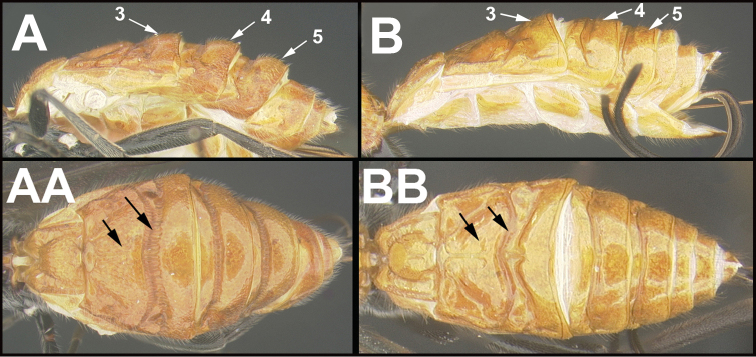
| ||

An official website of the United States government
Here's how you know
Official websites use .gov
A
.gov website belongs to an official
government organization in the United States.
Secure .gov websites use HTTPS
A lock (
) or https:// means you've safely
connected to the .gov website. Share sensitive
information only on official, secure websites.